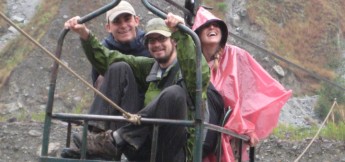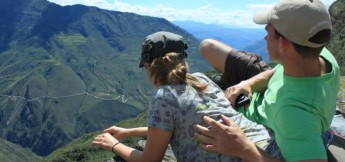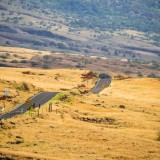Lago Titicaca

Here we are on lake Titicaca, the highest commercially navigable lake in the world.
[flickr]photo:5934165509[/flickr]
[flickr]photo:5934690782[/flickr]
I’ll pause here so everyone can make a titi and/or caca joke.
Lake Titicaca is home to islands both natural and man-made, and we can say from first-hand experience that both types are pretty epic.
[flickr]photo:5934746562[/flickr]
[flickr]photo:5934807046[/flickr]
[flickr]photo:5934995320[/flickr]
The man-made Uros islands are called the floating islands because they are made out of totora (a reed) that causes them to sit above the water. Totora is the same type of reeds used for the boats in Huanchaco called the caballitos de totora (see Huanchaco post). Though I must say that the figureheads on the totora boats of lake Titicaca make them much more impressive looking!
[flickr]photo:5934738280[/flickr]
[flickr]photo:5934296007[/flickr]
The islands rot quickly from the bottom, and so are constantly added to. Their inhabitants continuously weave new layers of totora on top of old. The islands are anchored with ropes (also made of totora) tied to sticks, which are then driven into the bottom of the lake.
[flickr]photo:5934423695[/flickr]
[flickr]photo:5934415595[/flickr]
The islands were originally created by the Uros people about 500 years ago as a defensive measure against the Incas. The Incas were threatening to take them over (as they did to just about everyone) and the Uros people built the islands so that entire communities could be easily moved away from threats. Unfortunately they were pretty much totally taken over by the Incas anyway, and the last full-blooded Uros Indian died in the 1950’s.
[flickr]photo:5934237107[/flickr]
The Uros people don’t just live on totora, it also represents the majority of their diet and medicines. When a reed is pulled, the white bottom is often eaten for it’s iodine content, as an iodine-rich diet can prevent goiter (crazy neck swelling). The Totora reeds are also chewed in the same way as coca leaves to abate hunger, or help with altitude sickness. If someone is in pain, the reed is wrapped around the place in pain to absorb it, and the white part of the reed can be rolled in one’s hands and split open and put on someone’s forehead to help with heat. The white part of the reed is also used to help ease hangovers, and to make a reed flower tea. Yeah, it’s pretty much a miracle plant.
[flickr]photo:5934265781[/flickr]
[flickr]photo:5934315593[/flickr]
Though the inhabitants live quite simply, with the harvesting of a reed taking up most of their time, there does seem to be an ample amount of solar panels so TV can be watched from their reed beds or music listened to from their reed chairs.
[flickr]photo:5934211165[/flickr]
[flickr]photo:5934419467[/flickr]
traveling store
[flickr]photo:5934414911[/flickr]
[flickr]photo:5934785742[/flickr]
There are over 70 floating islands. The biggest houses about 10 families and the smallest one or two. Each island has it’s own name and President. You know who the president is by the brightness of his hat. Only officials are allowed to wear the super awesome and righteous hats.
[flickr]photo:5934838896[/flickr]
The president of the island we visited has more than the average number of citizens to govern, 10 families consisting of 32 people.
[flickr]photo:5934231241[/flickr]
Though Jose, the President, dresses casually (see bare feet and sweatpants) he obviously cares about his people, as the job is an unpaid one. All of the responsibility with none of the perks!
[flickr]photo:5934848802[/flickr]
After visiting an Uros island, we headed over to Taquile island. A large natural island with over 2,200 inhabitants. Taquile is known for it’s weaving and textile work and was proclaimed as being totes awesome by UNESCO. The men of the island do all of the knitting, and begin learning at the tender age 6.
They walk around chatting with one another while constantly knitting away at a hat or belt with their needles.
Pretty sweet. Also you can tell if a man is single or married by the color of his hat, and if a woman is single or married by the size of her pom poms.
[flickr]photo:5934445029[/flickr]
I don’t know if I would ever want to get married if it meant downgrading the size of my pom poms. I mean, when it comes to pom poms the bigger the better, right?!
[flickr]photo:5934447415[/flickr]
[flickr]photo:5934438267[/flickr]
[flickr]photo:5934441677[/flickr]
[flickr]photo:5934997332[/flickr]
[flickr]photo:5934426749[/flickr]
[flickr]photo:5934454941[/flickr]
Tom and I have been going back and forth over the last couple of days about how we should spend our last few weeks of travel before we settle down to a three month house sit in Panama. We finally decided to go ahead and go to Bolivia, and so got to spend our last day in Peru making reservations, copies, print-outs, filling out paperwork and visiting the bank.
[flickr]photo:5935300396[/flickr]
Bolivia practices a policy called “reciprocity visas” which basically means that if the country you are a resident of is a dick to Bolivians, Bolivia is going to be a dick to you.
As we all know the US takes the world prize for being dicks to people trying to enter the country, and as such U.S. citizens fall under Bolivia’s most highly regulated migratory category.
The only flaw in the plan that I can see is that the US citizens who agree with the United States stringent and miserly visa regulations are probably not the ones visiting Bolivia. It is definitely interesting to see first hand what a pain in the butt all this visa paperwork can be.
[flickr]photo:5935297342[/flickr]
[flickr]photo:5935298800[/flickr]
Some US citizens are pretty angry about the whole thing. But to be honest I’m sure it’s still way harder for any Bolivian to visit the states than it was for us to get our visas. We say go ahead Bolivia, charge us a bunch of money and make us fill out a bunch of paperwork, because maybe one day the right person will try to enter Bolivia, figure out that it’s bogus and try to change some of the policies back home.
[flickr]photo:5934436419[/flickr]
[flickr]photo:5934414387[/flickr]
[wpgmappity id=”49″]















Love you guys. Sounds wonderful. Take care.
Mom
did you try the miracle plant? Why don’t we have that??
Your trip, writing and pictures continue to blow my mind! Love you!!!
Whoa, look at the size of HER pom-poms! (Since I’m over the titicaca jokes, this one made me laugh.)
Seriously, though, very beautiful and seems like such a charming place!
Be careful. I love you guys!
I’m glad to hear that you guys were able to get there without getting threatened with rocks.